Solar Energy Project Report: Nigeria's Renewable Energy
VerifiedAdded on 2022/07/28
|9
|2232
|23
Report
AI Summary
This report provides a comprehensive analysis of a solar energy project in Nigeria, examining its social, economic, and environmental factors. It highlights the increasing energy demand and the government's adoption of solar energy as a solution. The report delves into the economic benefits, such as cost-effectiveness and job creation, as well as the environmental advantages, including reduced greenhouse gas emissions and pollution. It also discusses government policies and regulations, including standards for renewable energy and feed-in tariffs, and their impact on project viability. Furthermore, the report explores the social and economic viability of solar energy, considering factors such as the availability of solar resources, low-cost capital, favorable regulations, and affordable technology. The report concludes by emphasizing the importance of renewable energy in addressing Nigeria's energy challenges and the potential of solar energy to provide electricity to its citizens. The report references a number of scholarly articles to support the findings.
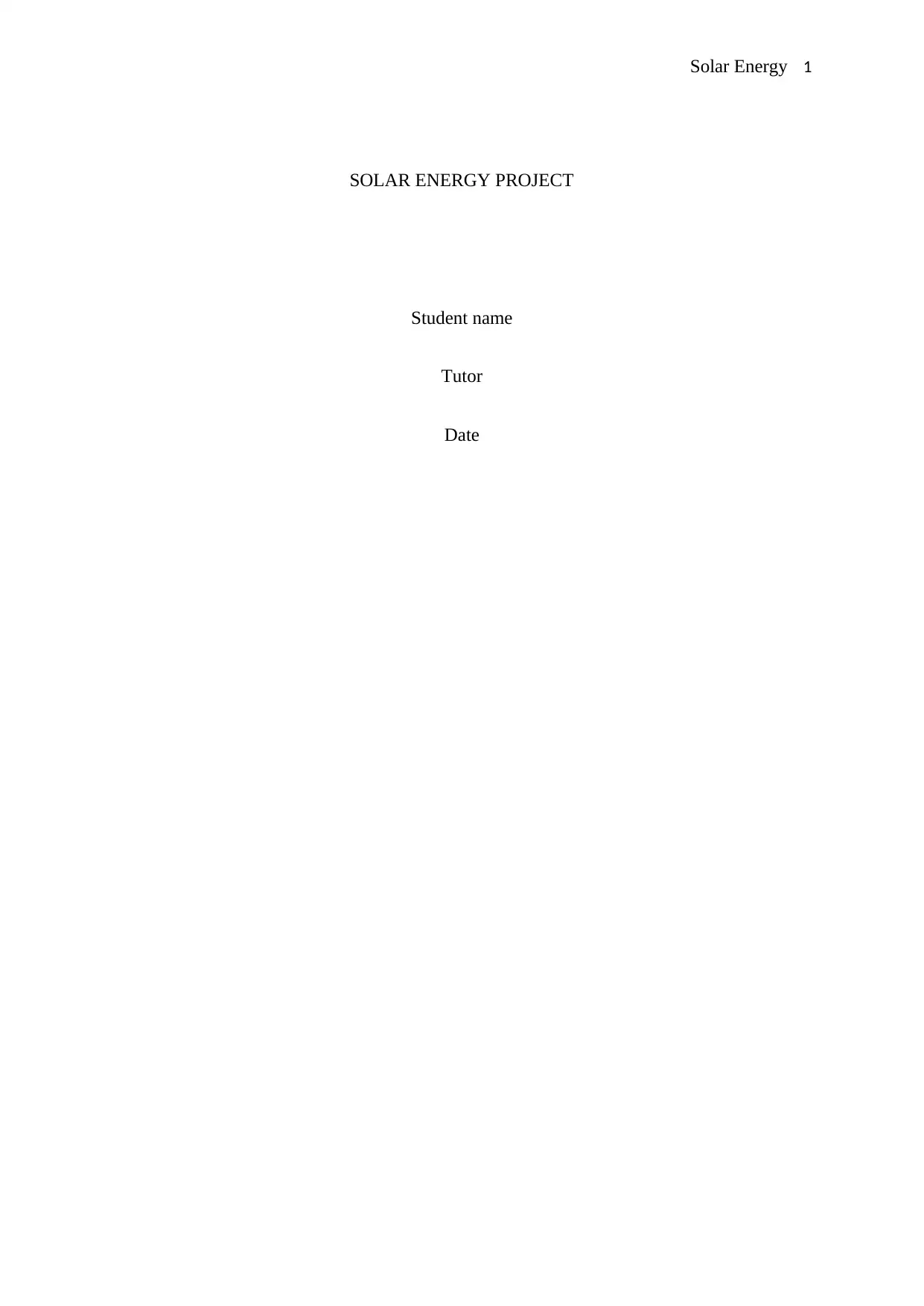
Solar Energy 1
SOLAR ENERGY PROJECT
Student name
Tutor
Date
SOLAR ENERGY PROJECT
Student name
Tutor
Date
Paraphrase This Document
Need a fresh take? Get an instant paraphrase of this document with our AI Paraphraser
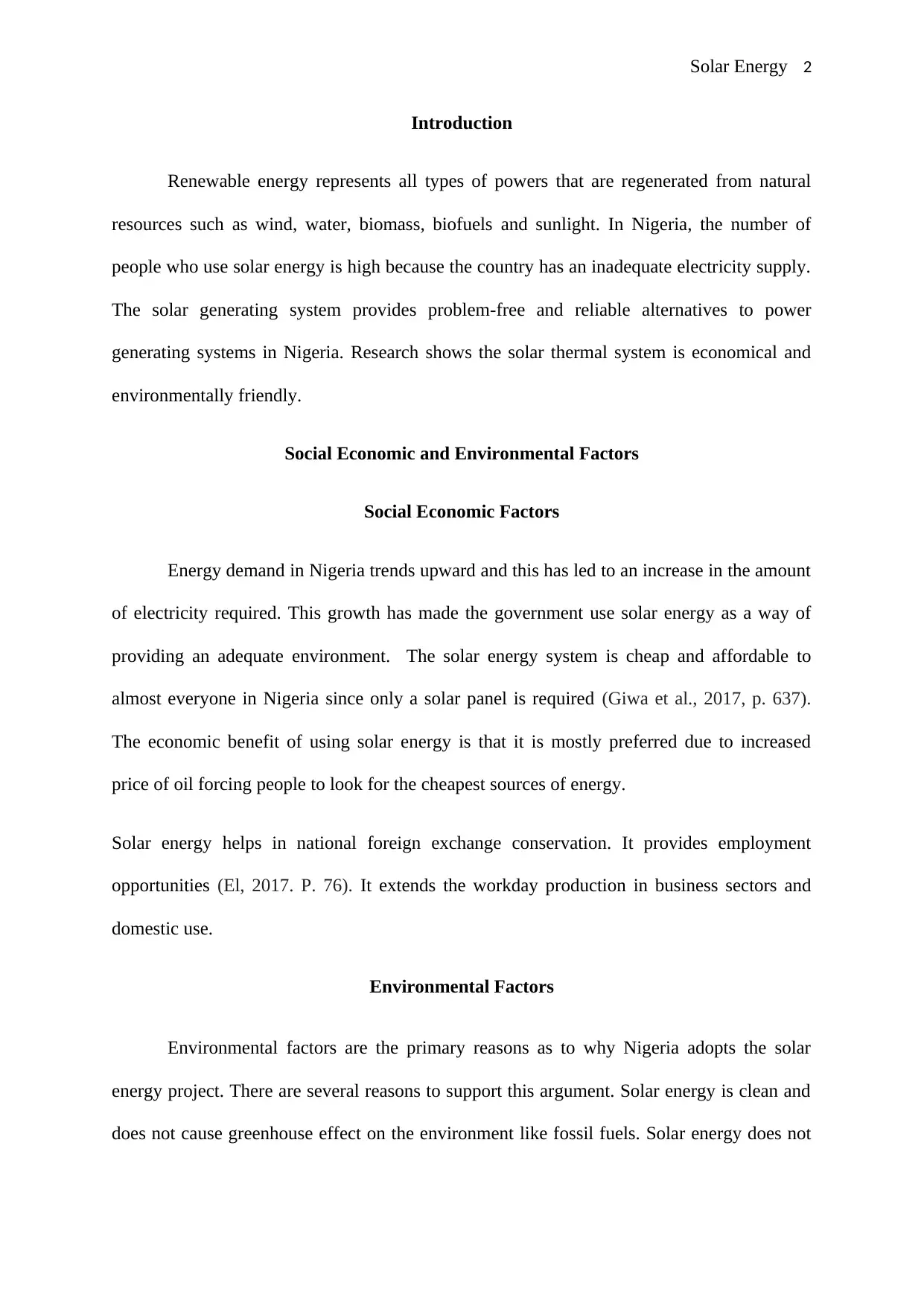
Solar Energy 2
Introduction
Renewable energy represents all types of powers that are regenerated from natural
resources such as wind, water, biomass, biofuels and sunlight. In Nigeria, the number of
people who use solar energy is high because the country has an inadequate electricity supply.
The solar generating system provides problem-free and reliable alternatives to power
generating systems in Nigeria. Research shows the solar thermal system is economical and
environmentally friendly.
Social Economic and Environmental Factors
Social Economic Factors
Energy demand in Nigeria trends upward and this has led to an increase in the amount
of electricity required. This growth has made the government use solar energy as a way of
providing an adequate environment. The solar energy system is cheap and affordable to
almost everyone in Nigeria since only a solar panel is required (Giwa et al., 2017, p. 637).
The economic benefit of using solar energy is that it is mostly preferred due to increased
price of oil forcing people to look for the cheapest sources of energy.
Solar energy helps in national foreign exchange conservation. It provides employment
opportunities (El, 2017. P. 76). It extends the workday production in business sectors and
domestic use.
Environmental Factors
Environmental factors are the primary reasons as to why Nigeria adopts the solar
energy project. There are several reasons to support this argument. Solar energy is clean and
does not cause greenhouse effect on the environment like fossil fuels. Solar energy does not
Introduction
Renewable energy represents all types of powers that are regenerated from natural
resources such as wind, water, biomass, biofuels and sunlight. In Nigeria, the number of
people who use solar energy is high because the country has an inadequate electricity supply.
The solar generating system provides problem-free and reliable alternatives to power
generating systems in Nigeria. Research shows the solar thermal system is economical and
environmentally friendly.
Social Economic and Environmental Factors
Social Economic Factors
Energy demand in Nigeria trends upward and this has led to an increase in the amount
of electricity required. This growth has made the government use solar energy as a way of
providing an adequate environment. The solar energy system is cheap and affordable to
almost everyone in Nigeria since only a solar panel is required (Giwa et al., 2017, p. 637).
The economic benefit of using solar energy is that it is mostly preferred due to increased
price of oil forcing people to look for the cheapest sources of energy.
Solar energy helps in national foreign exchange conservation. It provides employment
opportunities (El, 2017. P. 76). It extends the workday production in business sectors and
domestic use.
Environmental Factors
Environmental factors are the primary reasons as to why Nigeria adopts the solar
energy project. There are several reasons to support this argument. Solar energy is clean and
does not cause greenhouse effect on the environment like fossil fuels. Solar energy does not
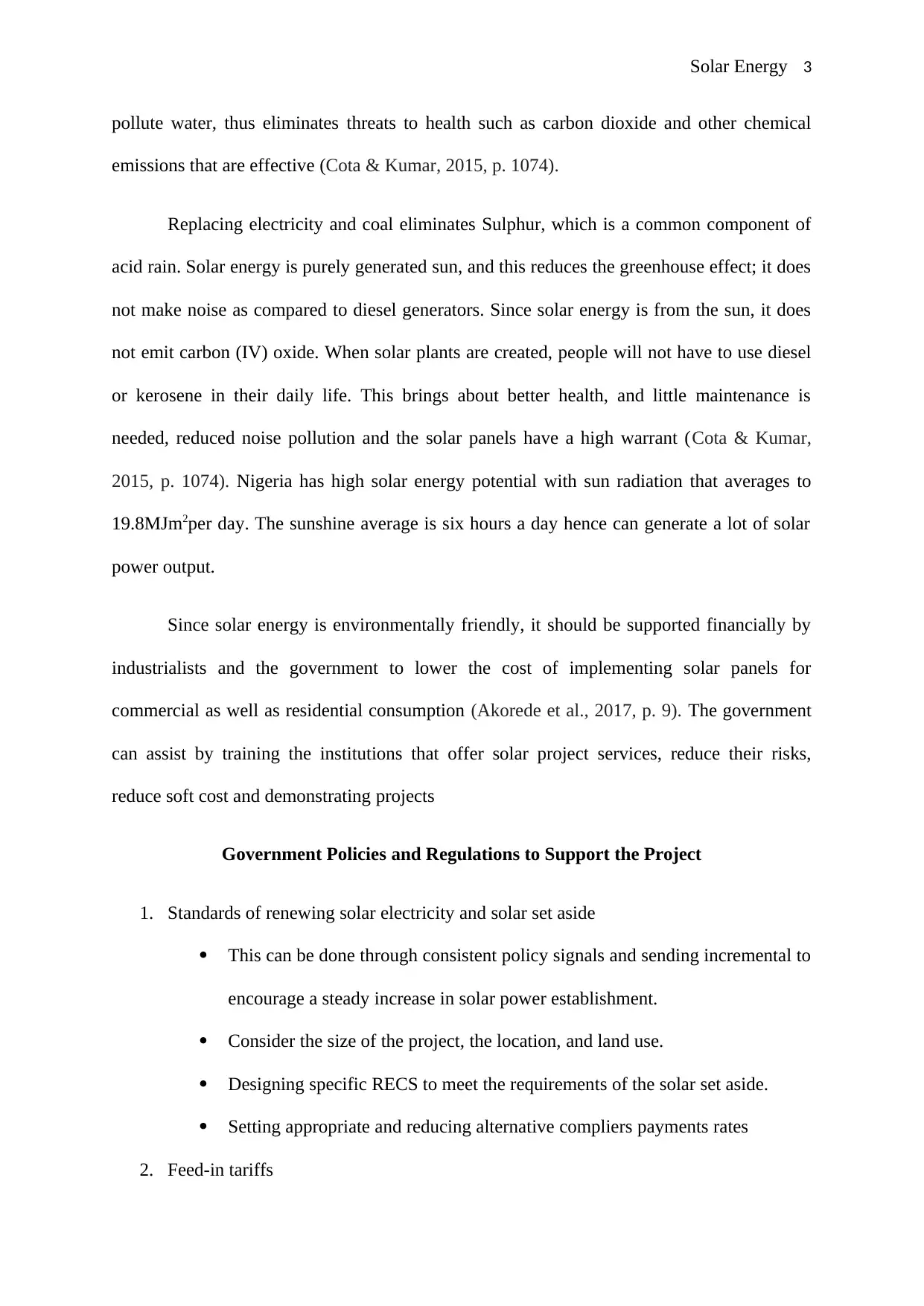
Solar Energy 3
pollute water, thus eliminates threats to health such as carbon dioxide and other chemical
emissions that are effective (Cota & Kumar, 2015, p. 1074).
Replacing electricity and coal eliminates Sulphur, which is a common component of
acid rain. Solar energy is purely generated sun, and this reduces the greenhouse effect; it does
not make noise as compared to diesel generators. Since solar energy is from the sun, it does
not emit carbon (IV) oxide. When solar plants are created, people will not have to use diesel
or kerosene in their daily life. This brings about better health, and little maintenance is
needed, reduced noise pollution and the solar panels have a high warrant (Cota & Kumar,
2015, p. 1074). Nigeria has high solar energy potential with sun radiation that averages to
19.8MJm2per day. The sunshine average is six hours a day hence can generate a lot of solar
power output.
Since solar energy is environmentally friendly, it should be supported financially by
industrialists and the government to lower the cost of implementing solar panels for
commercial as well as residential consumption (Akorede et al., 2017, p. 9). The government
can assist by training the institutions that offer solar project services, reduce their risks,
reduce soft cost and demonstrating projects
Government Policies and Regulations to Support the Project
1. Standards of renewing solar electricity and solar set aside
This can be done through consistent policy signals and sending incremental to
encourage a steady increase in solar power establishment.
Consider the size of the project, the location, and land use.
Designing specific RECS to meet the requirements of the solar set aside.
Setting appropriate and reducing alternative compliers payments rates
2. Feed-in tariffs
pollute water, thus eliminates threats to health such as carbon dioxide and other chemical
emissions that are effective (Cota & Kumar, 2015, p. 1074).
Replacing electricity and coal eliminates Sulphur, which is a common component of
acid rain. Solar energy is purely generated sun, and this reduces the greenhouse effect; it does
not make noise as compared to diesel generators. Since solar energy is from the sun, it does
not emit carbon (IV) oxide. When solar plants are created, people will not have to use diesel
or kerosene in their daily life. This brings about better health, and little maintenance is
needed, reduced noise pollution and the solar panels have a high warrant (Cota & Kumar,
2015, p. 1074). Nigeria has high solar energy potential with sun radiation that averages to
19.8MJm2per day. The sunshine average is six hours a day hence can generate a lot of solar
power output.
Since solar energy is environmentally friendly, it should be supported financially by
industrialists and the government to lower the cost of implementing solar panels for
commercial as well as residential consumption (Akorede et al., 2017, p. 9). The government
can assist by training the institutions that offer solar project services, reduce their risks,
reduce soft cost and demonstrating projects
Government Policies and Regulations to Support the Project
1. Standards of renewing solar electricity and solar set aside
This can be done through consistent policy signals and sending incremental to
encourage a steady increase in solar power establishment.
Consider the size of the project, the location, and land use.
Designing specific RECS to meet the requirements of the solar set aside.
Setting appropriate and reducing alternative compliers payments rates
2. Feed-in tariffs
⊘ This is a preview!⊘
Do you want full access?
Subscribe today to unlock all pages.

Trusted by 1+ million students worldwide
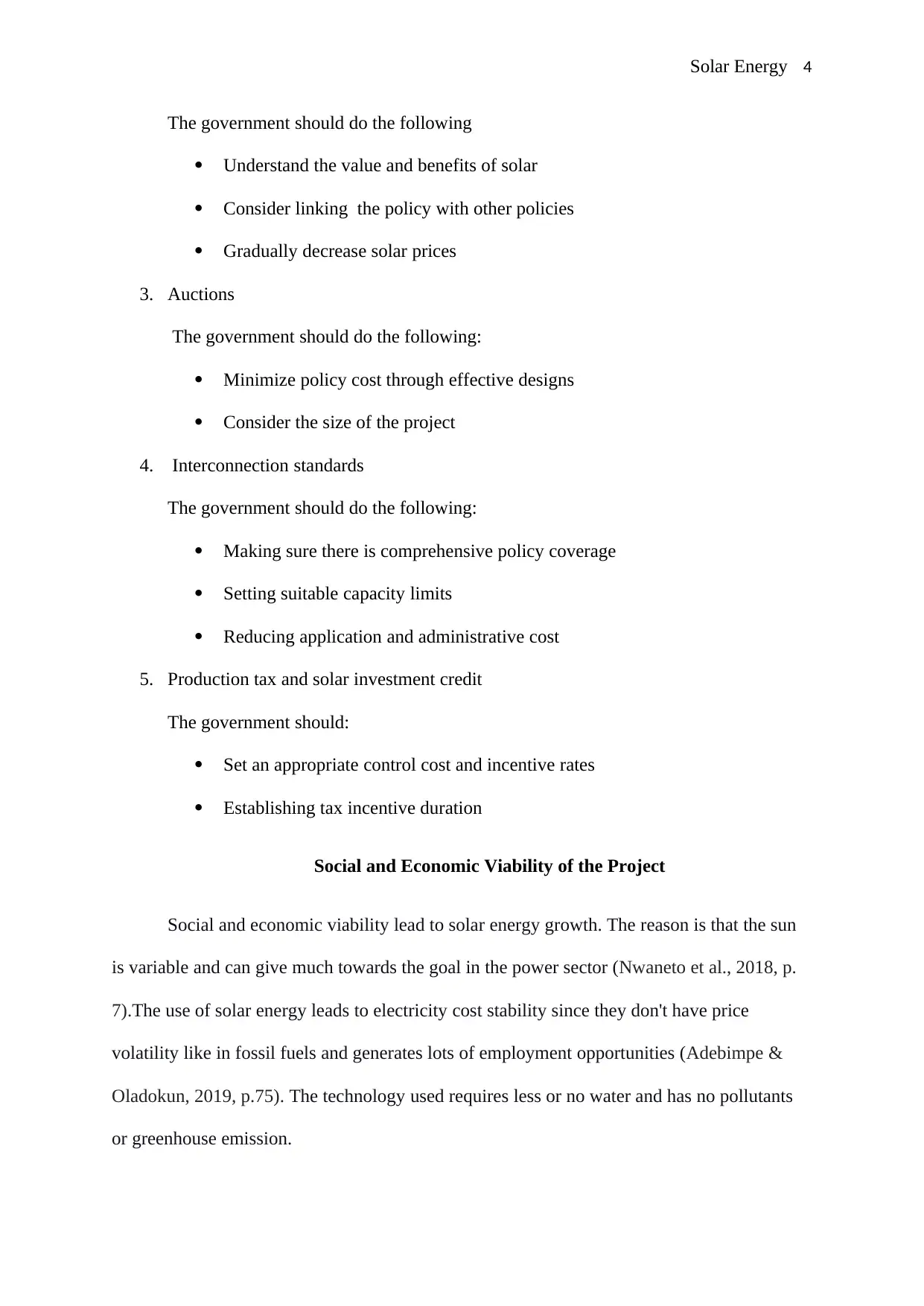
Solar Energy 4
The government should do the following
Understand the value and benefits of solar
Consider linking the policy with other policies
Gradually decrease solar prices
3. Auctions
The government should do the following:
Minimize policy cost through effective designs
Consider the size of the project
4. Interconnection standards
The government should do the following:
Making sure there is comprehensive policy coverage
Setting suitable capacity limits
Reducing application and administrative cost
5. Production tax and solar investment credit
The government should:
Set an appropriate control cost and incentive rates
Establishing tax incentive duration
Social and Economic Viability of the Project
Social and economic viability lead to solar energy growth. The reason is that the sun
is variable and can give much towards the goal in the power sector (Nwaneto et al., 2018, p.
7).The use of solar energy leads to electricity cost stability since they don't have price
volatility like in fossil fuels and generates lots of employment opportunities (Adebimpe &
Oladokun, 2019, p.75). The technology used requires less or no water and has no pollutants
or greenhouse emission.
The government should do the following
Understand the value and benefits of solar
Consider linking the policy with other policies
Gradually decrease solar prices
3. Auctions
The government should do the following:
Minimize policy cost through effective designs
Consider the size of the project
4. Interconnection standards
The government should do the following:
Making sure there is comprehensive policy coverage
Setting suitable capacity limits
Reducing application and administrative cost
5. Production tax and solar investment credit
The government should:
Set an appropriate control cost and incentive rates
Establishing tax incentive duration
Social and Economic Viability of the Project
Social and economic viability lead to solar energy growth. The reason is that the sun
is variable and can give much towards the goal in the power sector (Nwaneto et al., 2018, p.
7).The use of solar energy leads to electricity cost stability since they don't have price
volatility like in fossil fuels and generates lots of employment opportunities (Adebimpe &
Oladokun, 2019, p.75). The technology used requires less or no water and has no pollutants
or greenhouse emission.
Paraphrase This Document
Need a fresh take? Get an instant paraphrase of this document with our AI Paraphraser
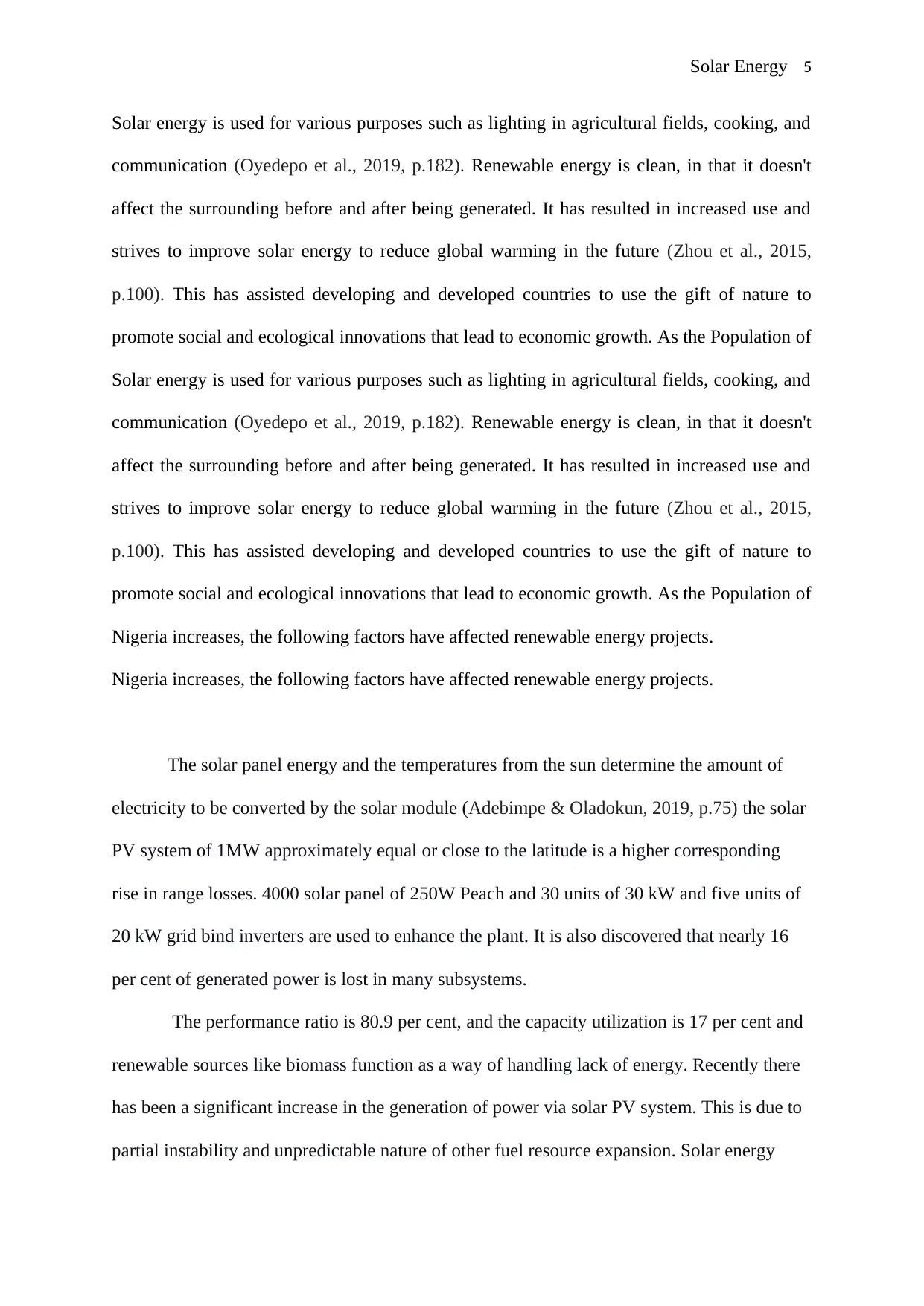
Solar Energy 5
Solar energy is used for various purposes such as lighting in agricultural fields, cooking, and
communication (Oyedepo et al., 2019, p.182). Renewable energy is clean, in that it doesn't
affect the surrounding before and after being generated. It has resulted in increased use and
strives to improve solar energy to reduce global warming in the future (Zhou et al., 2015,
p.100). This has assisted developing and developed countries to use the gift of nature to
promote social and ecological innovations that lead to economic growth. As the Population of
Solar energy is used for various purposes such as lighting in agricultural fields, cooking, and
communication (Oyedepo et al., 2019, p.182). Renewable energy is clean, in that it doesn't
affect the surrounding before and after being generated. It has resulted in increased use and
strives to improve solar energy to reduce global warming in the future (Zhou et al., 2015,
p.100). This has assisted developing and developed countries to use the gift of nature to
promote social and ecological innovations that lead to economic growth. As the Population of
Nigeria increases, the following factors have affected renewable energy projects.
Nigeria increases, the following factors have affected renewable energy projects.
The solar panel energy and the temperatures from the sun determine the amount of
electricity to be converted by the solar module (Adebimpe & Oladokun, 2019, p.75) the solar
PV system of 1MW approximately equal or close to the latitude is a higher corresponding
rise in range losses. 4000 solar panel of 250W Peach and 30 units of 30 kW and five units of
20 kW grid bind inverters are used to enhance the plant. It is also discovered that nearly 16
per cent of generated power is lost in many subsystems.
The performance ratio is 80.9 per cent, and the capacity utilization is 17 per cent and
renewable sources like biomass function as a way of handling lack of energy. Recently there
has been a significant increase in the generation of power via solar PV system. This is due to
partial instability and unpredictable nature of other fuel resource expansion. Solar energy
Solar energy is used for various purposes such as lighting in agricultural fields, cooking, and
communication (Oyedepo et al., 2019, p.182). Renewable energy is clean, in that it doesn't
affect the surrounding before and after being generated. It has resulted in increased use and
strives to improve solar energy to reduce global warming in the future (Zhou et al., 2015,
p.100). This has assisted developing and developed countries to use the gift of nature to
promote social and ecological innovations that lead to economic growth. As the Population of
Solar energy is used for various purposes such as lighting in agricultural fields, cooking, and
communication (Oyedepo et al., 2019, p.182). Renewable energy is clean, in that it doesn't
affect the surrounding before and after being generated. It has resulted in increased use and
strives to improve solar energy to reduce global warming in the future (Zhou et al., 2015,
p.100). This has assisted developing and developed countries to use the gift of nature to
promote social and ecological innovations that lead to economic growth. As the Population of
Nigeria increases, the following factors have affected renewable energy projects.
Nigeria increases, the following factors have affected renewable energy projects.
The solar panel energy and the temperatures from the sun determine the amount of
electricity to be converted by the solar module (Adebimpe & Oladokun, 2019, p.75) the solar
PV system of 1MW approximately equal or close to the latitude is a higher corresponding
rise in range losses. 4000 solar panel of 250W Peach and 30 units of 30 kW and five units of
20 kW grid bind inverters are used to enhance the plant. It is also discovered that nearly 16
per cent of generated power is lost in many subsystems.
The performance ratio is 80.9 per cent, and the capacity utilization is 17 per cent and
renewable sources like biomass function as a way of handling lack of energy. Recently there
has been a significant increase in the generation of power via solar PV system. This is due to
partial instability and unpredictable nature of other fuel resource expansion. Solar energy

Solar Energy 6
sustains the hydrology cycle, which has thermonuclear reactions that generate helium by
fusing hydrogen atoms (Sampaio et al., 2018, p.220). This process converts around 4 billion
kg of mass into power, the energy produced can be calculated using Einstein formula E=mC2
(Abdulkarim et al., 2020, P. 315). As a result of strong thermonuclear fusion reactions, the
sun sustains surface temperature of 5800 kelvins.
Outside the atmosphere, the radiation is 1367 watt per square meter that is called solar
constant. Around 40 per cent of pollution reaches the earth while the rest is reflected.
Resources Required for Project Success
Abundant Solar Resource
Ample solar supply could be done by installing efficient solar panels if the projects
don't get enough sunlight. Any obstacle that blocks sunlight reduces the output of solar power
(Abdullahi et al., 2017, p. 181). Some examples of these obstacles include hill, trees,
buildings, and billboards. The location of geography harms solar power. Any obstacle that
cast shadow on top of the solar panel is counterproductive.
Low-Cost Capital
It is common for solar panels to be installed with loans whose interest determines
whether the project is lucrative or not (Adewuyi, 2019, p. 115). For instance, if the solar
system has a return rate of 10, it means that a loan with interest below that is an attraction for
project implementation, any mortgage above that rate makes developers lose money.
Favourable Regulations
Solar power can do well in a country with a robust renewable energy portfolio. The
electric sector, which is open to private investments and incentives for solar energy, is the
best.
sustains the hydrology cycle, which has thermonuclear reactions that generate helium by
fusing hydrogen atoms (Sampaio et al., 2018, p.220). This process converts around 4 billion
kg of mass into power, the energy produced can be calculated using Einstein formula E=mC2
(Abdulkarim et al., 2020, P. 315). As a result of strong thermonuclear fusion reactions, the
sun sustains surface temperature of 5800 kelvins.
Outside the atmosphere, the radiation is 1367 watt per square meter that is called solar
constant. Around 40 per cent of pollution reaches the earth while the rest is reflected.
Resources Required for Project Success
Abundant Solar Resource
Ample solar supply could be done by installing efficient solar panels if the projects
don't get enough sunlight. Any obstacle that blocks sunlight reduces the output of solar power
(Abdullahi et al., 2017, p. 181). Some examples of these obstacles include hill, trees,
buildings, and billboards. The location of geography harms solar power. Any obstacle that
cast shadow on top of the solar panel is counterproductive.
Low-Cost Capital
It is common for solar panels to be installed with loans whose interest determines
whether the project is lucrative or not (Adewuyi, 2019, p. 115). For instance, if the solar
system has a return rate of 10, it means that a loan with interest below that is an attraction for
project implementation, any mortgage above that rate makes developers lose money.
Favourable Regulations
Solar power can do well in a country with a robust renewable energy portfolio. The
electric sector, which is open to private investments and incentives for solar energy, is the
best.
⊘ This is a preview!⊘
Do you want full access?
Subscribe today to unlock all pages.

Trusted by 1+ million students worldwide
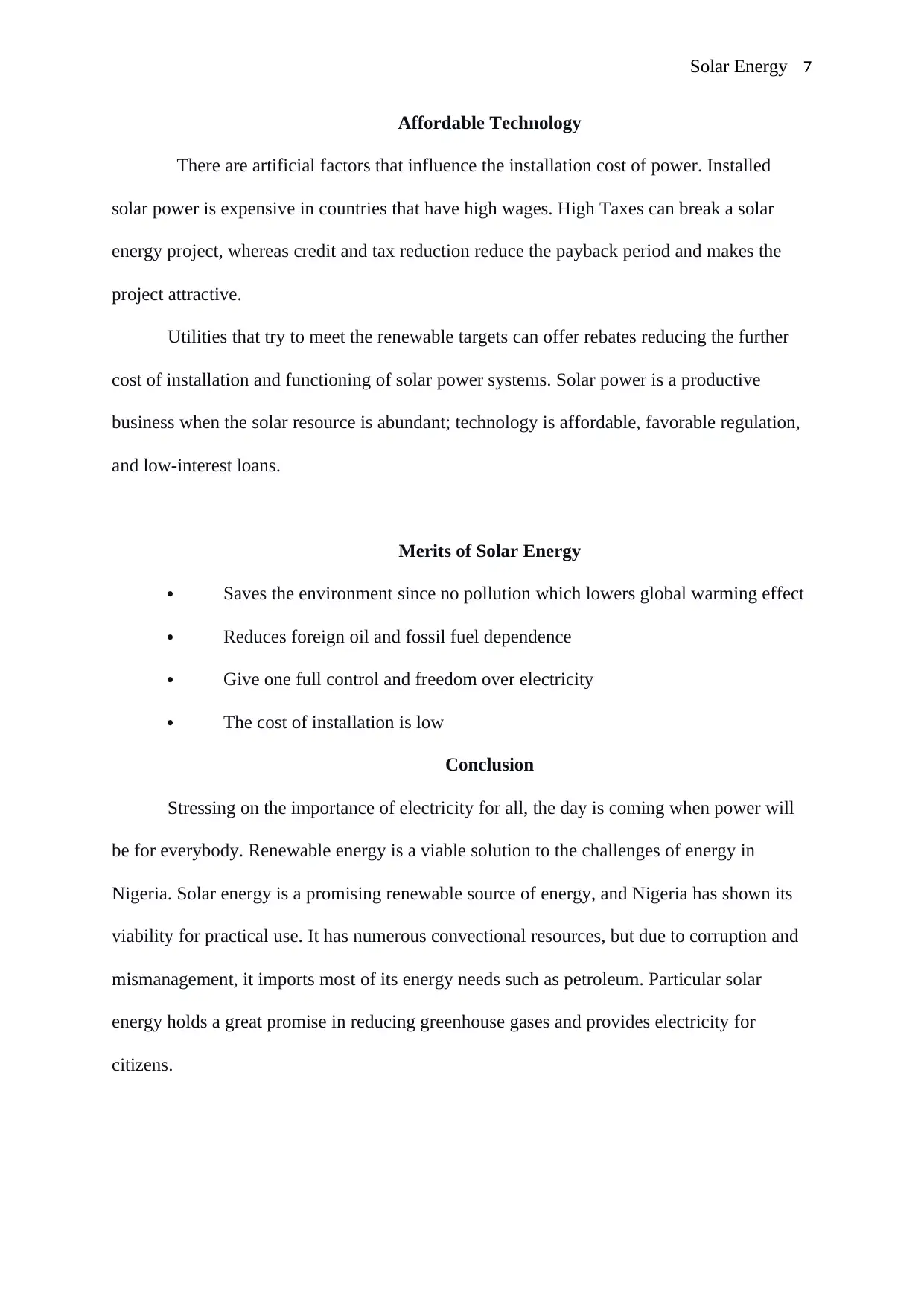
Solar Energy 7
Affordable Technology
There are artificial factors that influence the installation cost of power. Installed
solar power is expensive in countries that have high wages. High Taxes can break a solar
energy project, whereas credit and tax reduction reduce the payback period and makes the
project attractive.
Utilities that try to meet the renewable targets can offer rebates reducing the further
cost of installation and functioning of solar power systems. Solar power is a productive
business when the solar resource is abundant; technology is affordable, favorable regulation,
and low-interest loans.
Merits of Solar Energy
Saves the environment since no pollution which lowers global warming effect
Reduces foreign oil and fossil fuel dependence
Give one full control and freedom over electricity
The cost of installation is low
Conclusion
Stressing on the importance of electricity for all, the day is coming when power will
be for everybody. Renewable energy is a viable solution to the challenges of energy in
Nigeria. Solar energy is a promising renewable source of energy, and Nigeria has shown its
viability for practical use. It has numerous convectional resources, but due to corruption and
mismanagement, it imports most of its energy needs such as petroleum. Particular solar
energy holds a great promise in reducing greenhouse gases and provides electricity for
citizens.
Affordable Technology
There are artificial factors that influence the installation cost of power. Installed
solar power is expensive in countries that have high wages. High Taxes can break a solar
energy project, whereas credit and tax reduction reduce the payback period and makes the
project attractive.
Utilities that try to meet the renewable targets can offer rebates reducing the further
cost of installation and functioning of solar power systems. Solar power is a productive
business when the solar resource is abundant; technology is affordable, favorable regulation,
and low-interest loans.
Merits of Solar Energy
Saves the environment since no pollution which lowers global warming effect
Reduces foreign oil and fossil fuel dependence
Give one full control and freedom over electricity
The cost of installation is low
Conclusion
Stressing on the importance of electricity for all, the day is coming when power will
be for everybody. Renewable energy is a viable solution to the challenges of energy in
Nigeria. Solar energy is a promising renewable source of energy, and Nigeria has shown its
viability for practical use. It has numerous convectional resources, but due to corruption and
mismanagement, it imports most of its energy needs such as petroleum. Particular solar
energy holds a great promise in reducing greenhouse gases and provides electricity for
citizens.
Paraphrase This Document
Need a fresh take? Get an instant paraphrase of this document with our AI Paraphraser
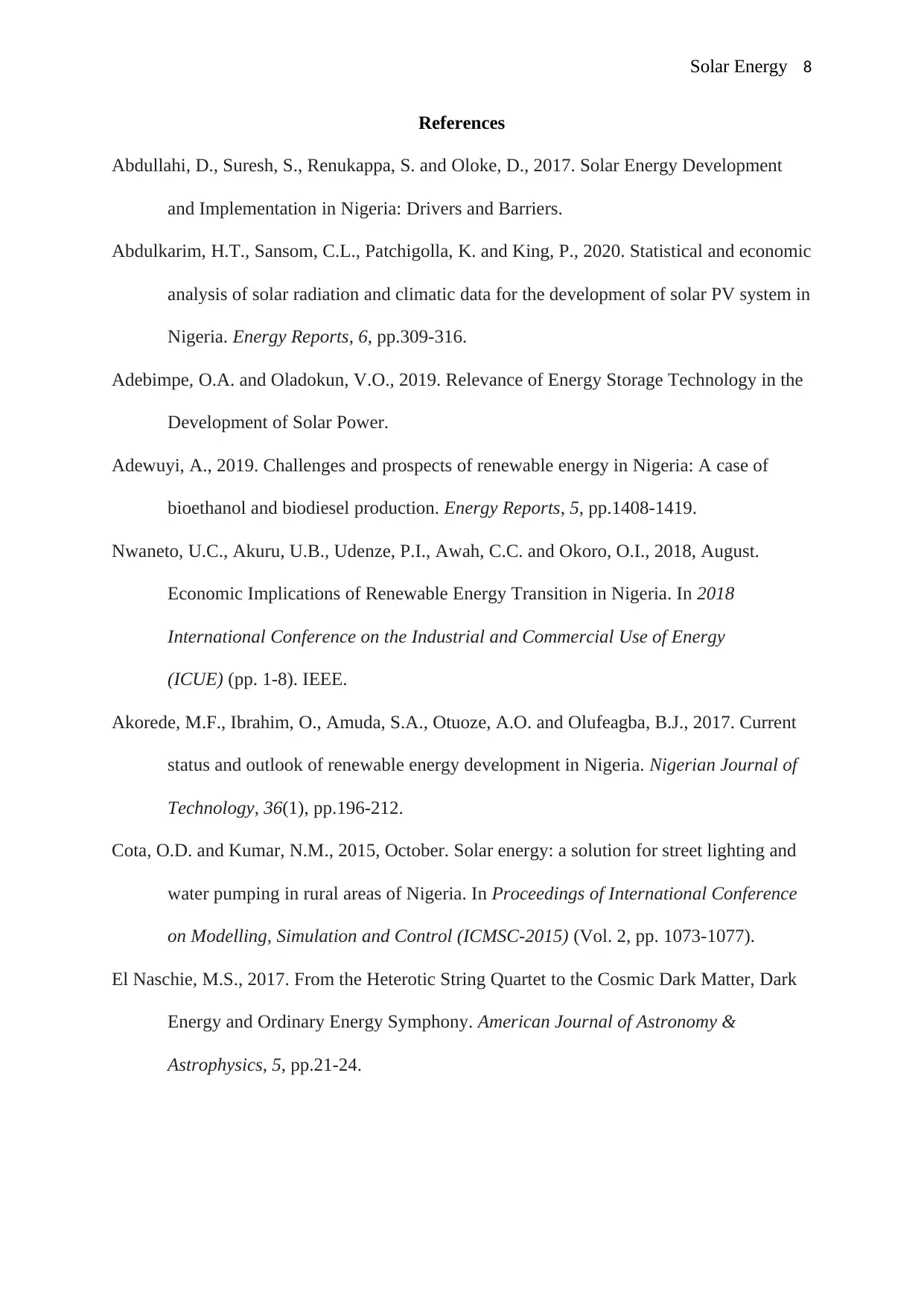
Solar Energy 8
References
Abdullahi, D., Suresh, S., Renukappa, S. and Oloke, D., 2017. Solar Energy Development
and Implementation in Nigeria: Drivers and Barriers.
Abdulkarim, H.T., Sansom, C.L., Patchigolla, K. and King, P., 2020. Statistical and economic
analysis of solar radiation and climatic data for the development of solar PV system in
Nigeria. Energy Reports, 6, pp.309-316.
Adebimpe, O.A. and Oladokun, V.O., 2019. Relevance of Energy Storage Technology in the
Development of Solar Power.
Adewuyi, A., 2019. Challenges and prospects of renewable energy in Nigeria: A case of
bioethanol and biodiesel production. Energy Reports, 5, pp.1408-1419.
Nwaneto, U.C., Akuru, U.B., Udenze, P.I., Awah, C.C. and Okoro, O.I., 2018, August.
Economic Implications of Renewable Energy Transition in Nigeria. In 2018
International Conference on the Industrial and Commercial Use of Energy
(ICUE) (pp. 1-8). IEEE.
Akorede, M.F., Ibrahim, O., Amuda, S.A., Otuoze, A.O. and Olufeagba, B.J., 2017. Current
status and outlook of renewable energy development in Nigeria. Nigerian Journal of
Technology, 36(1), pp.196-212.
Cota, O.D. and Kumar, N.M., 2015, October. Solar energy: a solution for street lighting and
water pumping in rural areas of Nigeria. In Proceedings of International Conference
on Modelling, Simulation and Control (ICMSC-2015) (Vol. 2, pp. 1073-1077).
El Naschie, M.S., 2017. From the Heterotic String Quartet to the Cosmic Dark Matter, Dark
Energy and Ordinary Energy Symphony. American Journal of Astronomy &
Astrophysics, 5, pp.21-24.
References
Abdullahi, D., Suresh, S., Renukappa, S. and Oloke, D., 2017. Solar Energy Development
and Implementation in Nigeria: Drivers and Barriers.
Abdulkarim, H.T., Sansom, C.L., Patchigolla, K. and King, P., 2020. Statistical and economic
analysis of solar radiation and climatic data for the development of solar PV system in
Nigeria. Energy Reports, 6, pp.309-316.
Adebimpe, O.A. and Oladokun, V.O., 2019. Relevance of Energy Storage Technology in the
Development of Solar Power.
Adewuyi, A., 2019. Challenges and prospects of renewable energy in Nigeria: A case of
bioethanol and biodiesel production. Energy Reports, 5, pp.1408-1419.
Nwaneto, U.C., Akuru, U.B., Udenze, P.I., Awah, C.C. and Okoro, O.I., 2018, August.
Economic Implications of Renewable Energy Transition in Nigeria. In 2018
International Conference on the Industrial and Commercial Use of Energy
(ICUE) (pp. 1-8). IEEE.
Akorede, M.F., Ibrahim, O., Amuda, S.A., Otuoze, A.O. and Olufeagba, B.J., 2017. Current
status and outlook of renewable energy development in Nigeria. Nigerian Journal of
Technology, 36(1), pp.196-212.
Cota, O.D. and Kumar, N.M., 2015, October. Solar energy: a solution for street lighting and
water pumping in rural areas of Nigeria. In Proceedings of International Conference
on Modelling, Simulation and Control (ICMSC-2015) (Vol. 2, pp. 1073-1077).
El Naschie, M.S., 2017. From the Heterotic String Quartet to the Cosmic Dark Matter, Dark
Energy and Ordinary Energy Symphony. American Journal of Astronomy &
Astrophysics, 5, pp.21-24.
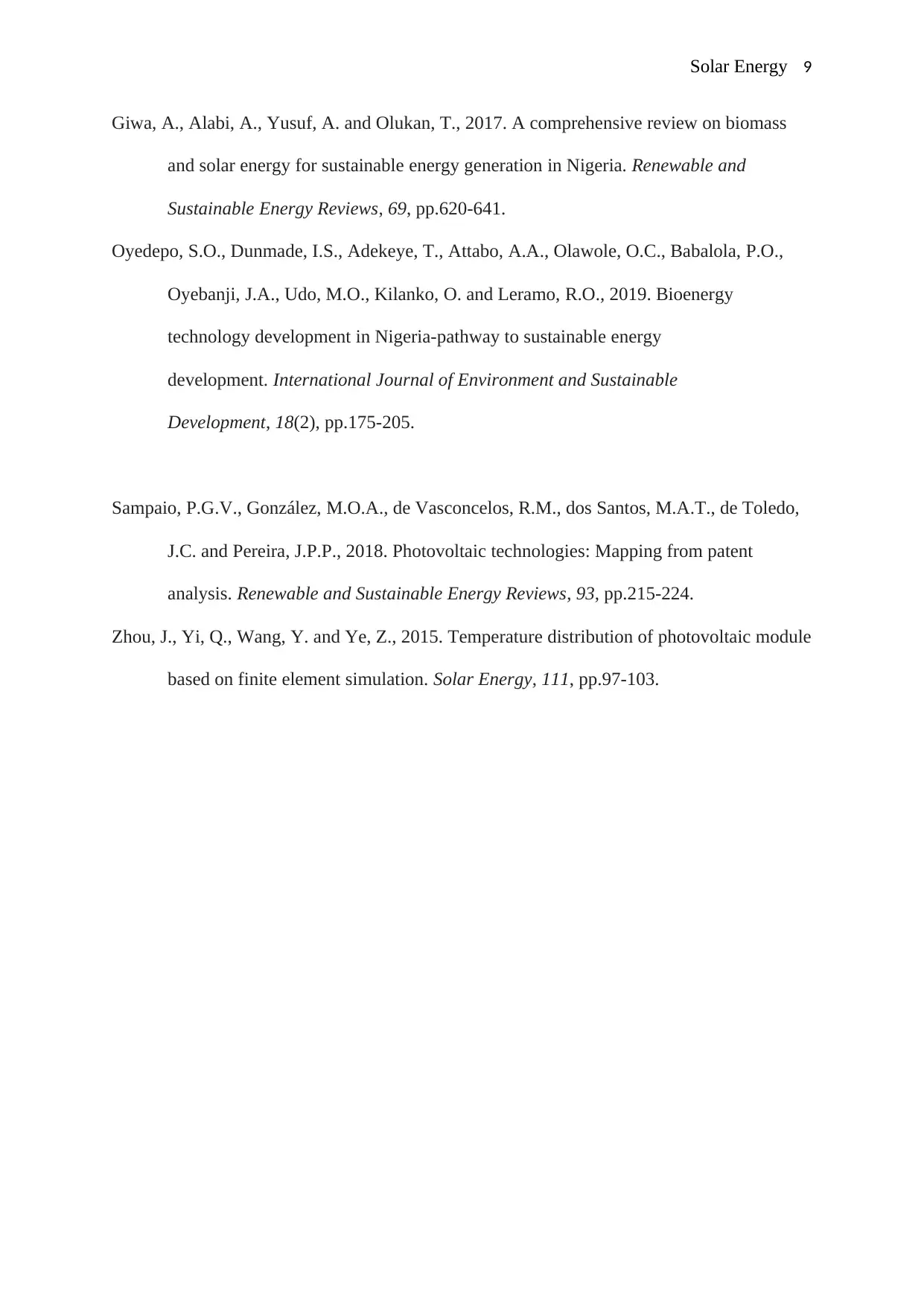
Solar Energy 9
Giwa, A., Alabi, A., Yusuf, A. and Olukan, T., 2017. A comprehensive review on biomass
and solar energy for sustainable energy generation in Nigeria. Renewable and
Sustainable Energy Reviews, 69, pp.620-641.
Oyedepo, S.O., Dunmade, I.S., Adekeye, T., Attabo, A.A., Olawole, O.C., Babalola, P.O.,
Oyebanji, J.A., Udo, M.O., Kilanko, O. and Leramo, R.O., 2019. Bioenergy
technology development in Nigeria-pathway to sustainable energy
development. International Journal of Environment and Sustainable
Development, 18(2), pp.175-205.
Sampaio, P.G.V., González, M.O.A., de Vasconcelos, R.M., dos Santos, M.A.T., de Toledo,
J.C. and Pereira, J.P.P., 2018. Photovoltaic technologies: Mapping from patent
analysis. Renewable and Sustainable Energy Reviews, 93, pp.215-224.
Zhou, J., Yi, Q., Wang, Y. and Ye, Z., 2015. Temperature distribution of photovoltaic module
based on finite element simulation. Solar Energy, 111, pp.97-103.
Giwa, A., Alabi, A., Yusuf, A. and Olukan, T., 2017. A comprehensive review on biomass
and solar energy for sustainable energy generation in Nigeria. Renewable and
Sustainable Energy Reviews, 69, pp.620-641.
Oyedepo, S.O., Dunmade, I.S., Adekeye, T., Attabo, A.A., Olawole, O.C., Babalola, P.O.,
Oyebanji, J.A., Udo, M.O., Kilanko, O. and Leramo, R.O., 2019. Bioenergy
technology development in Nigeria-pathway to sustainable energy
development. International Journal of Environment and Sustainable
Development, 18(2), pp.175-205.
Sampaio, P.G.V., González, M.O.A., de Vasconcelos, R.M., dos Santos, M.A.T., de Toledo,
J.C. and Pereira, J.P.P., 2018. Photovoltaic technologies: Mapping from patent
analysis. Renewable and Sustainable Energy Reviews, 93, pp.215-224.
Zhou, J., Yi, Q., Wang, Y. and Ye, Z., 2015. Temperature distribution of photovoltaic module
based on finite element simulation. Solar Energy, 111, pp.97-103.
⊘ This is a preview!⊘
Do you want full access?
Subscribe today to unlock all pages.

Trusted by 1+ million students worldwide
1 out of 9
Related Documents
Your All-in-One AI-Powered Toolkit for Academic Success.
+13062052269
info@desklib.com
Available 24*7 on WhatsApp / Email
![[object Object]](/_next/static/media/star-bottom.7253800d.svg)
Unlock your academic potential
Copyright © 2020–2025 A2Z Services. All Rights Reserved. Developed and managed by ZUCOL.





